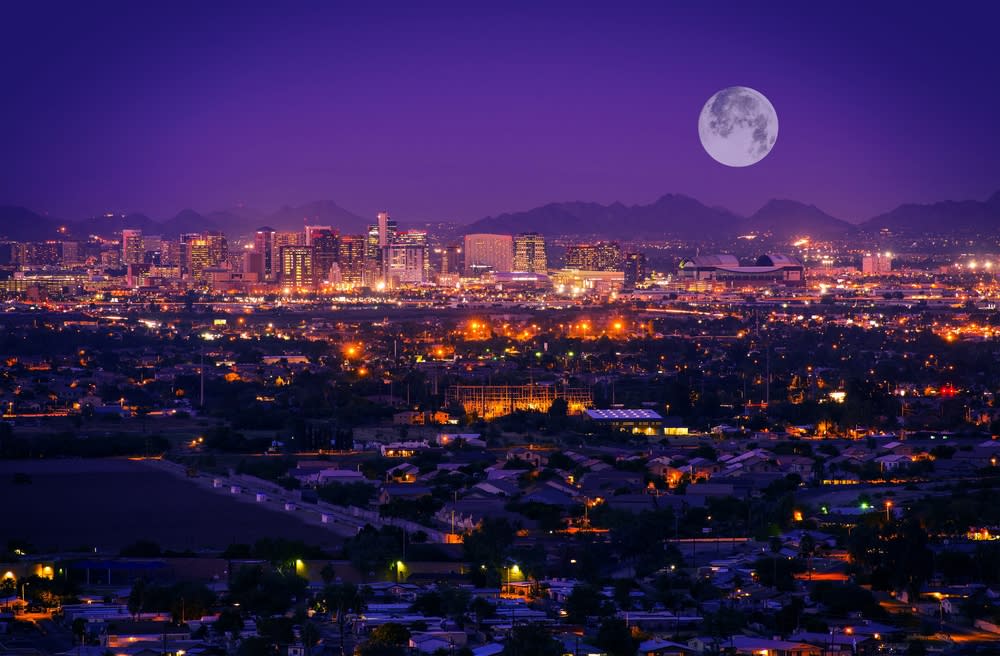More from Phoenix
Main Menu
- 00:00
- 06:00
- 12:00
- 18:00
- 23:00
Phoenix : Next 24-Hour Weather
Tomorrow - 14th April 2025
Sunrise 05:59
Sunset 18:59
Tomorrow - 15th April 2025
Sunrise 05:59
Sunset 18:59
Holiday Weather Now
Sorted by popularity:
Updated at 02:00 GMT
-
Temp feels like30°C86°F
-
Length of day13h 00m
-
Pressure29" (1012 hpa)
-
Visibility16 km (9miles)
-
Wind speed8 km/h
Sunrise 05:59
Sunset 18:59
-
Temp feels like:
30ºC (86 ºF)
-
Length of day:
13h 00m
-
Pressure:
29" (1012 hpa)
-
Visibility:
9 miles (16 km)
-
Wind speed:
8 km/h
Phoenix, the capital of Arizona and fifth most populous city in the USA, is reputed to have the hottest climate of any major city in the United States. Built over part of the Sonoran Desert, Phoenix has a subtropical arid climate which results in swelteringly hot summers, warm winters and clear skies. Night-time temperatures drop dramatically in subtropical arid climates due to the radiation loss experienced under clear skies.
Phoenix (which is also known as the Valley of the Sun) basks in a great deal of sunshine, typically receiving 85% of possible sun which is fantastic for those who like to soak up a few rays while on holiday. Rain is infrequent so you wonât have to worry about a sudden downpour when topping up your tan.
The summer temperatures in the city are similar to, if not slightly hotter than, popular vacation location Sharm El Sheikh in Egypt. The lowest recorded temperature in Phoenix is 16°F in January 1913 while the highest temperature was recorded in June 1990 at 122°F. With temperatures peaking over 120°F on occasion, it is advisable to pack lightweight, bright clothing to keep cool. However, in those conditions it may be more comfortable to cut arm and leg holes in your fridge and wear that instead!
There are plenty of parks to enjoy in and around the city and several water parks to keep residents and visitors cool. The Salt River runs through Phoenix although, due to the irrigation system, most of the water is siphoned off leaving the riverbed relatively dry. The city is also home to various mountains both within and in the surrounding area so thereâs lots of natural scenery.
Summer
The driest (and brightest) month is normally June while the warmest is July. The average lowest temperatures between June and August are 68°-75°F and the typical high temperatures for the same period range from 102°F to 106°F. There are normally 110 days in the year that see temperatures of over 100°F, these usually occur between late May and early September.
As well as scorching heat there are around 12 hours of sunlight per day in summer and 14 hours of sun per day is normal for June. Although rain is scarce at the start of summer, August tends to receive the most rain of the year (which is still not much as there is usually only five days of rain in August).
Winter
There is an Arizona Indian proverb concerning the onset of this season: âWhen smoke rises from the bottom lands and goes to the mountain, expect an early winterâ. The average low temperatures between November and January are recorded at 39°-46°F and the average high temperatures range from 66°F to 75°F.
The coolest month is December and there are only five days of the year that see the temperature drop to (or below) freezing. Frost often occurs in the outlying regions of the city during winter although snow is extremely rare and was last seen in December 1990. There tends to be between eight and nine hours of sun per day during winter. Rain remains scarce and fog is even rarer.

















